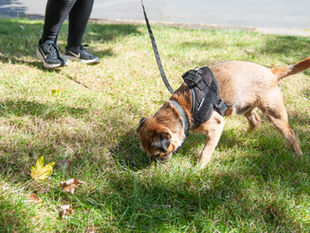
The Problems That Slip Leads Can Cause You and Your Dog
1
206
0
As a dog owner, it's essential to understand the tools you use for walking and training your furry friend. Worryingly, one that I am seeing more and more of is slip leads (and on puppies!). While it may seem convenient, the problems that slip leads can cause both physically and mentally for your dog should not be overlooked. In this post, I will explore the issues associated with slip leads and advocate for reward-based training methods instead.
What Are Slip Leads?
A slip lead is a type of leash that combines both a collar and a leash in one piece of equipment. It consists of a loop that tightens around the dog's neck when pulled, providing a method of control. While slip leads are often marketed as easy and effective solutions for managing dogs, they can lead to serious problems.

Common Issues Caused by Slip Leads
Physical Problems
Using a slip lead can cause a variety of physical health problems for your dog.
1. Neck Injuries
When the slip lead pulls tight, it can put significant pressure on your dog's neck. This pressure can lead to injuries such as tracheal collapse, especially in small or brachycephalic (short-nosed) breeds.
2. Choking Hazards
Slip leads can easily tighten around a dog's neck, leading to choking. This is particularly dangerous in scenarios where the dog is pulling away or lunging, as the sudden pressure can restrict airflow abruptly.
3. Strain on the Spine
A slip lead encourages dogs to pull. This pulling can cause strain not only on the neck but also on a dog's spine, potentially leading to long-term issues such as chronic pain or mobility problems.
Behavioural Problems
Beyond physical ailments, the use of slip leads can significantly affect your dog's behaviour.
1. Increased Anxiety
When a dog is pulled or choked by a slip lead, it can create a cycle of anxiety. Dogs may associate their walks with discomfort or fear, leading to increased stress and anxiety levels.
2. Aggression
Frustration from being restricted can lead some dogs to exhibit aggressive behaviours. The slip lead can act as a trigger, making the dog lash out at other dogs or people due to fear or stress.
3. Poor Leash Skills
Using a slip lead can contribute to poor leash manners. Rather than teaching a dog to walk alongside you calmly, it may reinforce pulling or lunging behaviour, making walks less enjoyable for both parties. People often think it will stop them pulling, if they feel it tighten around their neck, the problem is the dog is going to be excited and pumped with adrenaline when out on walks, so they often don't feel the extent and carry on pulling and afterwards the pain will kick in when resting. A bit like, when we are injured we often keep going in the moment, but the pain gets more intense later on.

The Importance of Reward-Based Training
Switching to reward-based training is crucial to addressing the issues caused by slip leads. This method relies on positive reinforcement, encouraging good behaviour while discouraging negative reactions.
Building Positive Associations
Using treats, praise, or toys as rewards can help your dog understand what is expected during walks. This creates a positive association with good behaviour, making the learning process enjoyable for both you and your dog.
Encouraging Calm Behaviour
Reward-based training promotes calmness rather than anxiety, helping your dog learn to walk alongside you without pulling. Mark and reward them instead by choosing to stay next to you without pulling.
A Range of Training Options
There are various options for training that don't involve slip leads. Harnesses, for example, can be beneficial as they distribute pulling pressure more evenly across the dog's body. This change can lead to fewer injuries and increase comfort during walks.

Statistics and Success Rates
Research shows that dogs trained using positive reinforcement methods tend to exhibit more desirable behaviours. According to a study published in the Journal of Veterinary Behaviour, positive reinforcement training methods have higher success rates in creating obedient dogs compared to aversive methods.
Moving Away from Aversive Tools
It's essential to realize that using aversive tools like slip leads can lead to deeply ingrained behavioural issues that may take time and patience to correct. Changing to a gentler training method can have lasting benefits for your dog's well-being and your relationship.
Understanding the Emotional Impact
Dogs are sensitive creatures; their emotional health is just as crucial as their physical health. Using aversive tools can damage the trust between you and your dog. Instead of teaching your dog what not to do through fear, consider building an understanding based on kindness and patience.
Final Thoughts
The problems that slip leads can cause are far-reaching, affecting both your dog's physical health and emotional well-being. Transitioning to reward-based methods not only promotes a happier walking experience for both you and your furry companion, but it fosters trust and strengthens your bond.
Make the decision today to prioritize your dog's well-being by moving away from slip leads and embracing kinder training approaches. The journey to a well-behaved and happy dog doesn't have to be paved with discomfort and fear—choose positivity.
By prioritizing your dog's health and using positive reinforcement techniques, you can pave the way for a brighter future for both of you.
If you need help with loose lead walking, I offer 121's or lead walking workshops, so visit www.paws-ontraining.co.uk today!

_JPG.jpg)








